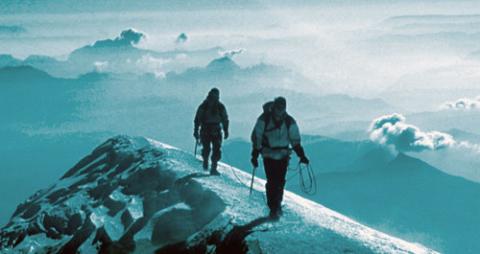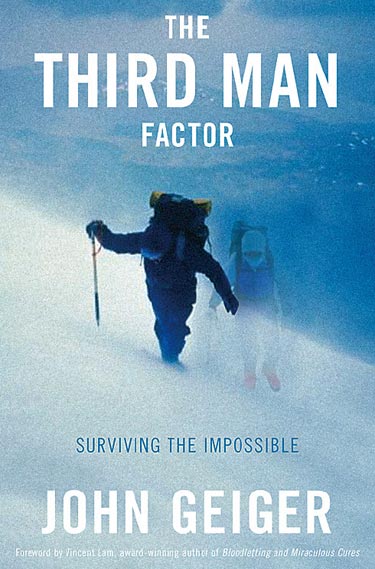Someone to watch over us

The history of exploration has seen many people caught in terrifying situations come into contact with a benevolent presence adventurers call the 'Third Man.' John Geiger has brought together these strange stories in a thrilling page-turner.
Review by Edward O’Hare
Most people are familiar with the story of how, after losing their ship and leaving behind twenty two of their team, Antarctic explorers Sir Ernest Shackleton, Frank Worsley and Tom Crean traversed the turbulent ocean south of Cape Horn and then trekked across the frozen terrain of South Georgia to raise a relief mission. It’s also known that to reach their objective they had to climb two mountain ranges, all the while moving in darkness and with no climbing gear. What is less well known is that, for the intrepid explorers, there was not three of them making this desperate survival bid but four.
The gallant trio were in no doubt that throughout the worst hours of their ordeal they were joined by the unseen presence of another person who led them to safety. Shackleton regarded the successful rescue of his men as his greatest triumph but when it came to describing what had helped him persevere he was imprisoned by the limits of language. “There are some things which can never be spoken of. Almost to hint about them comes perilously close to sacrilege. This experience was eminently one of those things,” he said.
What for Shackleton was a unique and deeply spiritual event has in actuality proven very common. John Geiger has spent the last five years amassing the stories of those who, often along with one other person, have encountered what has become known as the Third Man for his book, The Third Man Factor. References to the Third Man have appeared over and over again in the testimonies of extreme sports enthusiasts, mountaineers, divers, sailors, prisoners of war, disaster survivors and even astronauts. It is the overpowering conviction that there is someone watching over us, comforting us, guiding our actions and ensuring that we prevail.
What unites accounts of the Third Man is that it only appears to people in their hour of greatest need. Ron DiFrancesco heard the Third Man speak to him in the south tower of the World Trade Center after it was struck by the hijacked United Airlines Flight 175. He took it’s advice and was the last of only four people above the impact zone to escape. Diver Stephanie Schwabe was lost in an underwater cave when she felt the presence of another being who encouraged her to keep calm. She did, found her lifeline and made it to the surface. Astronaut Jerry Linenger was on the Mir space station when a raging fire broke out. He attributed his survival to a protective spectre he saw only in his periphery vision which led his hand to an oxygen mask.
It’s simple to dismiss the Third Man as the product of an imagination pushed to the very limit of sanity, but those who experience it are almost always people of exceptional mental resolution, trained to cope in extreme situations. John Geiger believes that the Third Man is not a delusion but a phenomena triggered by a multiplicity of elements including stress, high altitude, isolation, monotonous environment and low blood sugar and oxygen levels. As well as these, Geiger holds that the subject must exhibit an emotional openness, what he calls the ‘Muse Factor,’ if the Third Man is to come to their rescue.
Many people who encountered the Third Man are adamant that they had a religious experience, a meeting with their Guardian Angel or the soul of a loved one. Neuroscience has located an ‘Angel Switch’ in the left temporo-parietal junction, the part of the brain which organizes our sense-experience, which Geiger believes may be responsible for the Third Man. The Angel Switch, he argues, is an evolutionary defence mechanism which activates in life or death situations and makes us step outside of our being and see ourselves as another person who has come to save us.
Regardless of what may cause the Third Man, Geiger’s book about its many visitations is every bit the “natural history of adventure” he claims. Some of the stories, such as his accounts of A.R.F. ‘Sandy’ Wollaston’s calamitous expedition up New Guinea’s Mount Carstensz, submarine commander Henry Hugh Gordon Stoker’s (the cousin of Dracula author Bram Stoker) daring escape from a Turkish fortress across the Taurus mountains without compass, map or provisions and shipwrecked merchant seaman Kenneth Cooke’s amazing survival after more than 40 days aboard a raft in shark-infested waters off the west African coast, are simultaneously jaw-dropping, awe-inspiring and tremendously exciting. An utterly riveting mixture of exploration, science and adventure narratives, The Third Man Factor is the ideal mind-expanding thrill-ride of a book to bring along on holidays. It leaves you with a new understanding of what the human spirit can withstand.
 The Third Man Factor: Surviving the Impossible by John Geiger
The Third Man Factor: Surviving the Impossible by John Geiger
Canongate
252 pp
€11
